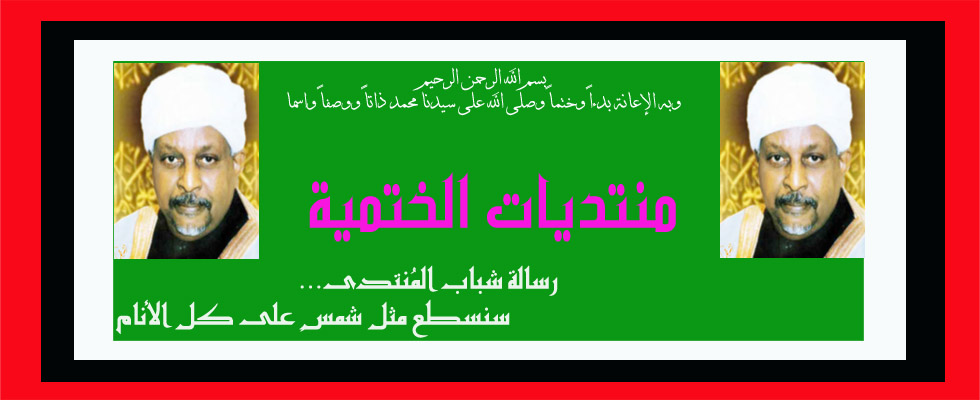 02-06-2011, 08:06 AM
02-06-2011, 08:06 AM
|
#1
|
|
مُشرف المنتدى الإنجليزي
|
 رد: Khatmiyya Leaders & Tariqa (all over the internet)
رد: Khatmiyya Leaders & Tariqa (all over the internet)
ohammed Uthman al-Mirghani known as Al-Khatim was the founder of the Khatmiyya sufi tariqa that has a following in Egypt, Sudan, Eritrea, Somalia and Ethiopia.
He was born into the Mirghani family in Mecca which was one of the most noble families that have descended from the Islamic prophet Muhammad. He is the son of Muhammad Abu Bakr who is the son of AbdAllah AlMahjoub who is the son of Ibrahim who is a descendant of the Prophet Muhammad. The lineage of Muhammad Othman AlMirghani was verified by Murtada AlZubeidi and this was further verified by Al-Jabarti in his book Taareekh AlJabarti / AlJabarti's History part two.
Muhammad Othman AlMirghani was born in Altayief and died in Mecca and was buried there in AlMa'alla. He lived a life of devotion to the spread of the Islamic faith in many parts of the world and many people embraced Islam through his teachings and example.[citation needed]
His sons followed in his footsteps after his death, the most famous of whom were Muhammad AlHassan AlMirghani, Gafar Elsadig AlMirghani, Abdullahi Almahjoub AlMirghani, Hashim AlMirghani and Sirr Alkhatim AlMirghani.
AlKhatim's religious journey began in Mecca from whence he travelled to Tarim in Yemen and then to Somalia by sea and to Massawa on the Red Sea coast where he travelled inland into the Ethiopian hinterland before returning to Mecca. On this trip tens of thousands of people embraced Islam including entire clans and tribes.
His second trip started from the Egyptian countryside south of Cairo and he was accompanied by his teacher Ahmad ibn Idris who parted ways with him in AlZeyniyyah. AlKhatim traversed the Nubian lands of the Mahas and the Sakot and went to Kordofan and reached the lands of the Fur people and the Borno tribe. He then travelled to Sennar on the banks of the Blue Nile and then to Shendi via Gezira and via the Butana to the Taka Mountain region near Kassala from which he entered into Ethiopia and visited many regions before returning to Mecca.
Muhammad Othman AlMirghani AlKhatim's methodology for calling people to Islam, "movementism," was characterized by travelling and being constantly on the move. This was due to the influence of Ahmad ibn Idris whose teachings and contribution coincided with a general, early Islamic renaissance during the Ottoman Caliphate. The customary, long-used methodology for an Islamic sheikh or Imam was to remain in his abode and for people to travel from afar to seek his audience. AlKhatim's "movementism" was the exact opposite of the customary methodology that had been prevalently used by Islamic sheikhs and Imams in his time.
"Movementism" was similarly taken up by another of Ahmad ibn Idris's disciples, AlSanoussi, who travelled to the Maghreb. However, AlKhatim travelled to regions and peoples where Islam was unknown and, if there was any knowledge of Islam, it was through the East African Slave Trade which caused many of these peoples to be hostile toward Islam. Examples of such regions are the Ethiopian Highlands and Eritrea and the southern region of the Blue Nile State and the Nuba Mountains, all of which have difficult terrains and complex tribal systems. AlKhatim, at only 25 years of age, managed to overcome personal physical risk, the harsh geography and the tribal complexities of these lands to call its people to Islam and to set up mosques and Islamic centres of learning which created a link between these lands and the Islamic World. Among his achievements was the establishment of the first teaching centre for the education of women in Sudan. His literary contribution to Islam spanned a wide range of topics from the explanation of the Holy Quran (Taj Altafaseer), through the listing of the Hadith (Fateh Al-Rasool), Fiqh and behaviour (Munjiyat Al-Abeed), Muhammedan Biography (Al-Asrar Al-Rabaniya Fi Mawlid Khair Al-Bareya), Madeeh or description of the Muhammedan traits (Alnour Al-Barraq Fi Madh Al-nabiy Al-Misdaq) to specific writings on many aspects of the Islamic religion. These are estimated to have reached over 112 many of which are yet to be disclosed.
|

|

|







 |
|  |
|
